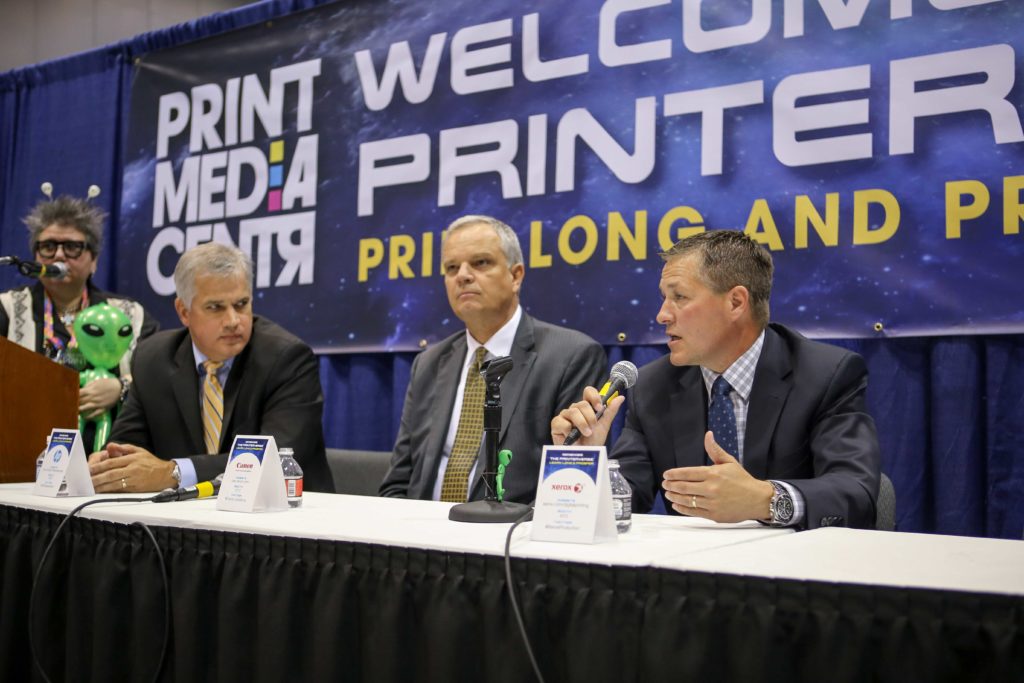
One of the promises of production inkjet printing is that its cost, speed and capacity advantages over traditional toner presses will lead to wider use of highly effective personalized printing and multi-channel campaigns. And that may be what’s behind the evolving view of personalized, multi-channel communications that emerged this week at the Graph Expo show in Chicago.
For many in the industry, terms such as multi-channel, cross-channel and omni-channel are interchangeable for describing communications that are orchestrated through more than one channel. However, during the Xplor breakfast customer panel on Tuesday, Sept. 15, moderator Matt Swain, group director, InfoTrends, offered distinctive definitions of each of these terms that were instructive for offering a development path. His definitions:
- Multi-channel: The reality today, customers see multiple touch points that act independently and are created by brands whose contributing knowledge and operations are in silos.
- Cross channel: Customers see multiple touch points as part of the same brand, and brands have a single view of the customer but still operate in silos.
- Omni channel: The nirvana state, customers experience a brand, not a channel within a brand, and brands leverage the single view of their customer in a strategic and coordinated way. “It’s a progression of multi-channel marketing, which encompasses a seamless approach to the customer experience across all sales channels,” Swain said.
Addressing the customer experience is critical, Swain said. The InfoTrends annual business survey found that improving the customer experience is the No. 1 communications priority among businesses. And a consumer survey found that the best ways to improve customer loyalty—other than the No. 1 response, providing discounts—were letting customers select their communications preferences, adding more payment options and personalizing their experience. That’s what omni-channel communications enable, making it a powerful tool for scratching the corporate itch to improve the customer experience.
And where there’s business potential, there is hype. Even Swain called the multiple terms for multi-channel, “buzz words.” And not everyone on the customer panel of inkjet users—Randy Seberg of Innovairre, Mark Laube of the Microdynamics Group and Dan Beery of RR Donnelley—has adopted the omni-channel terminology. “I’m glad you gave that explanation (for omni-channel marketing), because I didn’t know what that was,” Seberg said, eliciting a laugh. Rather, the worldwide leader in fundraising for agencies and not-for-profits, and an early adopter of the Xerox CiPress 500 Inkjet Production System, calls it “full-circle communications,” Seberg said.

XMPie also has been offering omni’s seamless communications across all media channels for years via its suite of one-to-one marketing software. Judy Berlin, vice president, XMPie Marketing, attended the session and said she hopes the InfoTrends’ omni-channel communications concept will bring new momentum to one-to-one adoption. “If the new term omni-channel marketing helps people understand the concept better, that’s great,” she said, adding that advancements with the XMPie platform introduced at Graph Expo make it even easier to create and deliver these programs.
Later that morning, another panel, presented by the PrintMediaCentr, offered a reminder of why industry leaders are so focused on omni-channel marketing. The “I Can’t Believe it’s not Offset, Everything You Need to Know About the Inkjet Revolution” panel featured Canon’s Guy Broadhurst, HP’s David Murphy and Xerox’s Dustin Graupman. They discussed the latest in the inkjet technology that promises to greatly expand print’s presence in omni-channel marketing in the coming years.
Are you pursuing these growth opportunities to improve the experience of your customers’ customers? Where do multi-, cross-, omni, full-circle communications fit in?




Comments are closed.